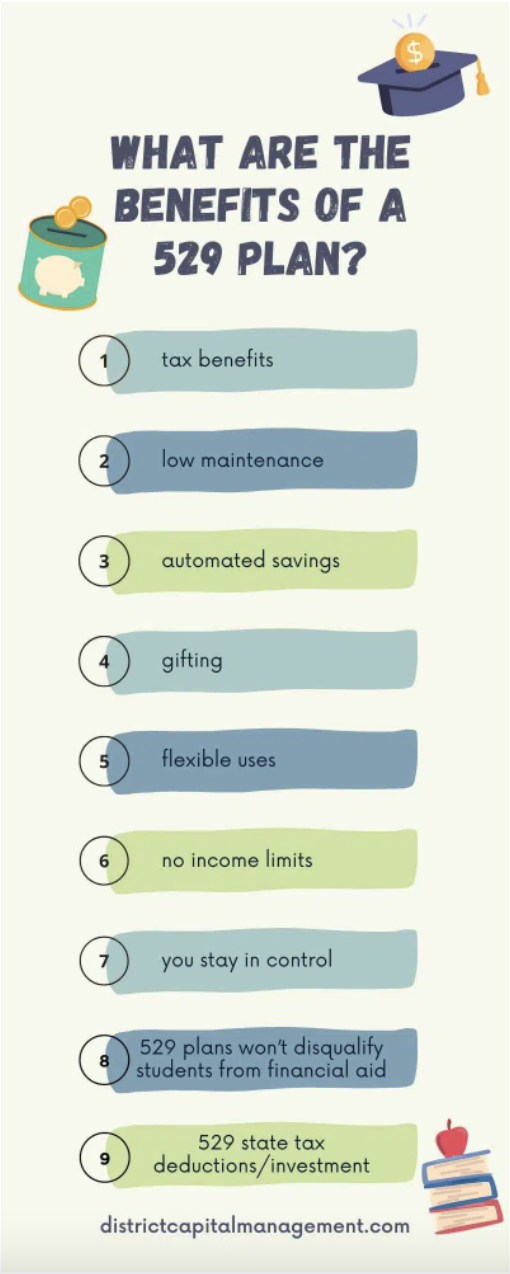9 Benefits Of A 529 Plan
Share this

7.0 MIN READ
A 529 plan can be a great tax-advantaged way to save for college for your children. Having a 529 plan can make it affordable and convenient to start saving early on. This can make a huge difference in the financial future of your children. Let’s talk about 9 benefits of a 529 plan and why this might be right for you and your family.
What is a 529 Plan?
A 529 plan allows you to save for education. You add funds into the 529 account, and then you invest those funds to allow them to grow in the years prior to needing that money. When you withdraw that money for a qualified education expense, the growth of the account comes out tax-free. There are many benefits to 529 plans, so let’s get into those now.
1. Tax Benefits
529 plans come with federal tax benefits, and some state tax benefits (depending on your state). The federal benefits come from the gains in a 529 plan not being taxed when they’re used for qualified educational expenses. For example, if you contribute every year into your child’s 529 plan for 18 years, and invest that money for all 18 years, a good portion of that account would likely be made up of growth. The gains on this account would come out completely tax-free when used for qualified education expenses.
Many states also give tax deductions on your state tax return in the years that you contribute to the 529 plan. So you’re getting the state tax deduction now, and a federal tax break later.
2. 529 Plans are Low Maintenance
Investing in a 529 plan is actually quite simple. Most plans have age-based investment choices that will invest based on the age of the child, or the time horizon until the money is going to be withdrawn, as well as risk tolerance. This will automatically make your investments more aggressive in the beginning and less aggressive the closer it gets to the time of withdrawal. Alternatively, you can choose individual funds if you don’t like the age-based funds. The age-based funds make it low maintenance because the investments will adjust on their own, but it can be too aggressive for some people.
3. You Can Automate Your 529 Savings
Most 529 plans will allow you to set up automated savings at a specified time, i.e.monthly or yearly, directly out of your bank account and into the 529. They will also allow you to set up automated investments. This means that any new contributions into the account will automatically be invested into the investment section you have chosen. 529 savings are extremely low maintenance after the initial setup.
4. Gifting
One great thing about a 529 plan is that anybody can contribute to it, not just the owner. Most plans will offer a simplified way for other people to gift money to the account. Many plans will provide a link for you to send to people. This allows others to contribute directly into your child’s 529 plan. It makes it very easy for family members and friends to contribute to your child’s future education.
Another gifting benefit of the 529 plan is that you can put $16,000 per year per person into a 529 plan without having to file a gift tax return. This takes advantage of the federal yearly gift tax exemption. Anybody can put $16,000 per year into this account to take advantage of their own yearly gift tax exemption.
You also have the option of front-loading a 529 plan for up to five years. For example, you can contribute $80,000 ($16,000 yearly exemption x 5) per person into the 529 in one single tax year. If you’re married, you and your spouse can each contribute $80,000 for a total of $160,000 in one tax year to each child’s 529 plan without having to tap into your lifetime gift and estate tax exemption. This could allow family members to transfer wealth over time with no tax implications.
Be careful of front loading a 529 plan if you live in a state that offers a state tax deduction. If the state doesn’t allow front-loading, you would want to leave enough of that money per year to contribute to take advantage of the full state tax deduction. Contact your financial advisor or tax professional if you’re not sure how much you should put into your 529 plan.
5. Flexible Uses
Many people are reluctant to contribute to a 529 plan because they’ve been told that they can only use it to pay for traditional higher education tuition. The question that I get asked by clients often is “what if my child chooses not to go to college or gets a scholarship? Do I have to pay a tax penalty when I take that money out of the 529?” This is a common fear, and a great question. After all, we can’t see into the future.
If you take the money out of the 529 plan for a non-qualified expense, you will pay taxes on the growth, and possibly be hit with a 10% tax penalty. This is enough to turn many people away from using 529 plans for college savings. However, many don’t understand that the 10% penalty only applies on the earnings.
Luckily, the uses for 529 plans have gotten more flexible over the years. 529 plans can be used for many higher education expenses, including trade schools, private high schools, certain room and board expenses, and other education expenses. There are also situations in which you would not have to pay the penalty even if you don’t use the money for education expenses. For example, if your child receives a scholarship or becomes disabled, then you do not have to pay the 10% penalty when you withdraw money out of this account. However, you will still have to pay taxes on the earnings.
Another option is to transfer this account to another person in your family. Maybe you have another child (or yourself, a niece or nephew), who is going to attend a more expensive university, and your first child got a scholarship. You can always transfer the 529 funds to someone else in the family to use.
There are many other flexible uses and exceptions to the 10% distribution penalty rule, so we recommend that you look into all of these rules before deciding whether a 529 plan is right for you and your family.

6. No Income Limits
Unlike many other education benefits that provide tax advantages, such as a Coverdell, ESA, and certain education tax deductions and credits, 529 plans do not have income limits. Regardless of your income, you can take advantage of the federal tax benefits a 529 plan provides.
7. You Stay in Control
Unlike a savings account like an UGMA or UTMA, where the money becomes the child’s rightful property at age 18, a 529 stays in the name and control of the owner, not the beneficiary. Often this is a grandparent or parent. For example, if you open a 529 for your first child, and your first child turns 18 and decides not to go to college, you do not have to turn this money over to them. The account is still in your name and you are still the owner. You can change the beneficiary of this account to yourself, another family member, or another child. There’s flexibility in who can receive the benefits of this account.
8. 529 Plans Won’t Disqualify Students from Financial Aid
The 529 plan stays in the names of the parents and not in the name of the child. This means that the calculations used in the federal aid formula are much more favorable than if you were to use a savings account or brokerage account that transfers assets to the child. See the Federal Student Aid website for more information on how these assets are calculated.
9. 529 State Tax Deductions/Investment
Knowing that each 529 Plan is different, how do you decide which to use? Do you simply choose the plan that belongs to your state? That answer depends on two questions: One, does your resident state offer tax deductions for 529 contributions? And two, does your plan offer low fee investment fund options?
If your state offers both of these, it’s an easy decision. Go with your state 529. If your state offers neither one of these, or your state has no income taxes and the plan choices aren’t great, you may want to choose a plan from another state. While this won’t allow you to take a state tax deduction from another state, you can take advantage of low fee investment choices.
Take a look at the chart below to determine what benefits your state 529 Plan has.
529 State Tax Deductions/Investment
| State | State Tax Deduction Offered | Low Fee Investment Choices Available* |
|---|---|---|
| Alabama | ✓ | ✓ |
| Alaska | No State Income Tax | ✓ |
| Arizona | ✓ | ✓ |
| Arkansas | ✓ | X |
| California | X | ✓ |
| Colorado | ✓ | ✓ |
| Connecticut | ✓ | ✓ |
| Delaware | X | ✓ |
| Florida | No State Income Tax | ✓ |
| Georgia | ✓ | ✓ |
| Hawaii | X | X |
| Idaho | ✓ | X |
| Illinois | ✓ | ✓ |
| Indiana | ✓ | ✓ |
| Iowa | ✓ | ✓ |
| Kansas | ✓ | ✓ |
| Kentucky | X | ✓ |
| Louisiana | ✓ | ✓ |
| Maine | X | ✓ |
| Maryland | ✓ | ✓ |
| Massachusetts | ✓ | ✓ |
| Michigan | ✓ | ✓ |
| Minnesota | ✓ | ✓ |
| Mississippi | ✓ | X |
| Missouri | ✓ | ✓ |
| Montana | ✓ | X |
| Nebraska | ✓ | ✓ |
| Nevada | No State Income Tax | X |
| New Hampshire | No State Income Tax | ✓ |
| New Jersey | X | ✓ |
| New Mexico | ✓ | ✓ |
| New York | ✓ | ✓ |
| North Carolina | X | ✓ |
| North Dakota | ✓ | X |
| Ohio | ✓ | ✓ |
| Oklahoma | ✓ | ✓ |
| Oregon | ✓ | ✓ |
| Pennsylvania | ✓ | ✓ |
| Rhode Island | ✓ | ✓ |
| South Carolina | ✓ | ✓ |
| South Dakota | No State Income Tax | ✓ |
| Tennessee | No State Income Tax | ✓ |
| Texas | No State Income Tax | ✓ |
| Utah | ✓ | ✓ |
| Vermont | ✓ | ✓ |
| Virginia | ✓ | ✓ |
| Washington, DC | ✓ | ✓ |
| Washington | No State Income Tax | X |
| West Virginia | ✓ | X (Smart 529 Select) ✓ (Smart529 Direct) |
| Wisconsin | ✓ | ✓ |
| Wyoming | No State Income Tax | X |
Is a 529 Plan Right for You and Your Family?
A 529 plan can be a great way to save for your children’s college early on. You can take advantage of compound interest and all of the benefits we outlined above.
 About the Author
About the Author
Alvin Carlos is the founder of District Capital Management, an independent, fee-only financial planning firm. He helps professionals and entrepreneurs in their 30s and 40s elevate their finances and maximize their money.
Did you know XYPN advisors provide virtual services? They can work with clients in any state! View Alvin's Find an Advisor profile.
Share this
Subscribe by email
You May Also Like
These Related Stories

Saving and Paying for College: What Are Your Best Options?

How Should Parents Plan for A Child’s College Education?



